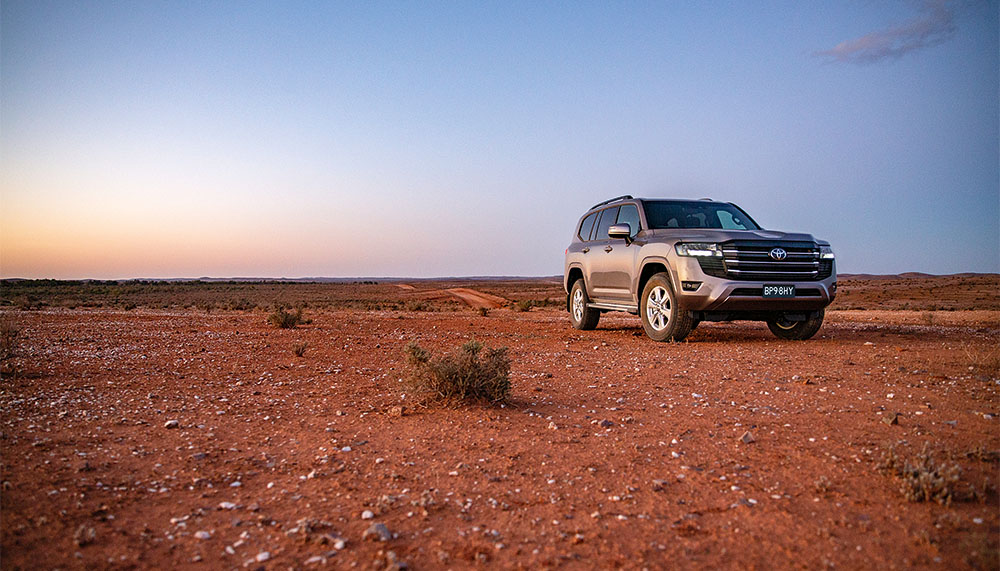Toyota’s latest LandCruiser adds a fresh chapter to an Australian story.
Story Bruce McMahon
From Birdsville to Broome, across the Plenty and down the Gunbarrel, the Toyota LandCruiser is an automotive legend. Much of the Japanese 4WD’s international recognition was based around early history in Australia, first working on the Snowy Mountains Hydro-Electric Scheme in the 1950s and 1960s, and then becoming a go-to vehicle for explorers, pastoralists and travellers.
Toyota had missed out on an American defence contract for the Korean War effort in 1951 with copies of the Willys Jeep. That let-down spurred the company to pay closer attention to international customer demands. Australians became the most important of those clients and, since the mid-1950s, have helped shape the three branches of LandCruisers: the workmanlike 70 Series, the flagship station wagons and smaller Prado versions.
The latest of these – and perhaps the most anticipated – is the full-sized LandCruiser 300 Series, following in the tracks of the 60 Series of 1981, the 80 in 1990, the 100 in 1998 and the 200 Series of 2007. Again, the new wagons’ development centred around local and Japanese engineers belting prototypes through Australian conditions while also listening to customers. The result is a meld of well-established basics and today’s technologies.
The 300 Series LandCruiser sits on a new chassis, with a fresh and lighter five-door body offering much the same dimensions inside and out. It may look narrower, with more slab-sided body, and it also feels narrower inside, with a wider centre console creating a snug, ‘cockpit’ impression up front, but at up to 5m long and 2m wide there’s plenty of space for seven adults in most models.
Not everyone is taken with the new style. The general thought among 200 Series owners is that this one has lost some of a Cruiser’s rugged road presence. There’s also been disconcertion in some quarters about the powerplant. The V8 diesel has been replaced in all six variants by a 3.3L, twin turbocharged V6 diesel, producing 227kW at 4000rpm and 700Nm of torque, which is actually 27kW and 50Nm better than the outgoing V8. Allied to a smooth 10-speed automatic transmission, this V6 is rarely found wanting – on or off-road – but the claimed 8.9L per 100km on the combined cycle may have to wait until the motor has a few kilometres under its belt. The best seen on test was an average 13L on gentle highway runs. There’s plenty of fuel on board though, with 110L capacity in two tanks.
Out on wide, open roads, the 300 Series sits sure for a big 4WD wagon. Pushed hard into a slow turn, there is some body lean (which is to be expected in a high-riding, three-tonne machine) and minimal body movement over corrugations with the body-on-frame construction. There’s now 10mm more ground clearance but, with engine and transmission moved back a tad, the vehicle’s centre of gravity is down 6mm.
Reworked front and rear suspensions feature more aluminium components, stronger coil springs up front and, down back, more vertical shock absorbers with longer rebound stroke. Ride, hydraulic steering and handling are good. The Cruiser turns and tracks with confidence and feels well at home on a gravel road.
Off-road, the LandCruiser 300s are confident and capable. All arrive with 4WD low range and lockable centre differential. The GXL model and up offer Toyota’s multi-terrain system, allowing drivers to select a drive mode, adapting engine, transmission and braking responses for different surfaces. Best of aids is the crawl button, used for steepish descents or ascents, which lets the vehicle’s electronics find the best traction at a constant speed set by the driver, easily adjusted on the go if necessary. This lets a driver concentrate on steering.
Moving up through the model grades and the price range, there are even more sophisticated suspension systems and traction aids. Most buyers, though, would give the track away well before a GXL Cruiser runs into serious trouble.
The $102,000, seven-seater GXL is likely to have most appeal as the all-round family wagon. Among comforts and conveniences are pre-collision safety system, active cruise control, blind spot monitor, 18-inch alloy wheels, wireless phone charger, six USB ports, a 23cm-wide centre screen and voice recognition. The stereo is excellent, with full marks for old-school knobs and switches – touchscreens aren’t always functional in 4WD territory. Top marks for having the on-off button for the lane departure system just under the right thumb on the steering wheel. These systems, which tug at steering if crossing a lane marking without using indicators, are a new-fangled nuisance on country roads, and Toyota’s LandCruiser 300 Series will be seeing plenty of country roads.
This story excerpt is from Issue #142
Outback Magazine: April/May 2022










